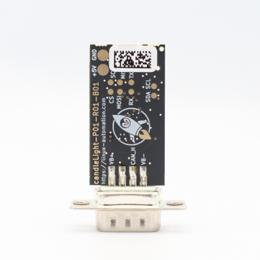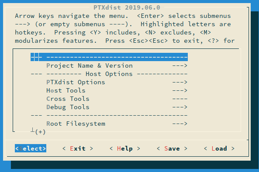PTXdist: Did you know? Today: Just a reboot
While the development on an embedded system I need to reboot it quite often. Doing so I appreciate to keep the required steps as less as possible and be sure the embedded system uses the recently changed data in a consistent manner.
I never want to be a disk jockey, moving around an SD card, writing it here, using it there, just to test a little change in my root filesystem. It needs too much time and its boring.
That's why I want to run my embedded system via network only. And here "only" means, it includes the kernel and its devicetree as well. I presume the bootloader of the embedded system supports the NFS protocol and also the BootLoaderSpec (if you are using the bootloader barebox you are already in a nice position). Both features in addition to an NFS service support the possibility to run the embedded system solely and in a consistent manner via network. The NFS service possibilities I already discussed here.
I'm using the bootloader barebox on all of mine embedded systems, so it will be a prerequisite for this example.
The NFS service must export the BSP subdirectory platform-<name>/root. It is the root filesystem dedicated for the embedded system and the embedded system must use a path to this directory from its point of view. The BSP subdirectory is created when the command ptxdist go has run.
Initially the bootloader barebox must configure its network interface. Its possible to configure it statically or via DHCP.
To load the Linux kernel and its devicetree via network, I need to define an additional automount entry in the barebox environment. On my embedded system I'm using the eth0 interface for the network, so my automount entry looks like that:
barebox:/ edit /env/init/automount
[...]
mkdir -p /mnt/nfs
automount /mnt/nfs 'ifup eth0 && mount -t nfs ${eth0.serverip}:/<path> /mnt/nfs'
[...]
The <path> component is just a placeholder here and it must be replaced by the path to the NFS export of the BSP's root filesystem directory.
Now the bootloader barebox is already using the network, but the Linux kernel needs an additional parameter as well to make use of the network and NFS for its root filesystem. barebox will add this required parameter automatically if the BootLoaderSpec config file contains the line linux-appendroot true. More about this detail will follow. That's all to be done at the embedded system.
At the PTXdist side (my development host) its sufficient to enable the entry default bootloader spec entry in the submenu bootloader spec entries in the platform configuration. Due to PTXdist does not automatically add the linux-appendroot true line mentioned above, I have to add it by my own. In order to, I copy the file default.conf from the path projectroot/loader/entries in the PTXdist installation directory to my local BSP into the projectroot/loader/entries directory and add the required linux-appendroot true line to it. It now should look like this:
title @TITLE@
version @VERSION@
options @CMDLINE@
linux-appendroot true
linux @KERNEL@
@DEVICETREE@
Now I run the ptxdist go command to create the root filesystem directory on my local harddisk, start the NFS service (if not already done) and switch on my embedded system. I can now boot my embedded system simply by typing the command:
barebox:/ boot /mnt/nfs
Doing so looks like this at my side:
barebox 2017.09.0 #2 Mon Sep 04 11:55:04 CEST 2017
Board: jb's board
detected i.MX53 revision 2.1
running /env/bin/init...
Hit any key to stop autoboot: 3
barebox:/ boot /mnt/nfs
booting 'PTXdist - jb's board'
blspec: booting PTXdist - jb's board from none
Adding "root=/dev/nfs nfsroot=192.168.23.4:/<path>,v3,tcp ip=dhcp" to Kernel commandline
Loading ARM Linux zImage '/mnt/nfs//boot/zImage'
Loading devicetree from '/mnt/nfs//boot/imx53-board.dtb'
commandline: root=/dev/nfs nfsroot=nfsroot=192.168.23.4:/<path>,v3,tcp ip=dhcp
My embedded system is DHCP configured and thus barebox automatically adds this method to the kernel command line (ip=dhcp). Here the <path> component mentioned above appears as well. barebox has extracted this parameter automatically from the automount entry and appended it in a suitable way to the kernel command line.
To avoid to re-type the mentioned boot command after each start or reset, I can configure it as the default:
barebox:/ nv boot.default=/mnt/nfs
barebox:/ saveenv
As for me, I am already relaxed at work and let the high pressure do its work in my coffee maker instead...
Further Readings
Yes we CAN... add new features
Have you ever experienced an otherwise fine product that is missing just the one feature you need for your application?
DSA in Barebox
The v2022.05.0 Release of barebox introduced initial support for the Distributed Switch Architecture (DSA) Framework. DSA is originally a subsystem from the Linux Kernel, which exposes the individual ports of a network switch IC as virtual network interfaces.
First Steps using the candleLight
So you went and got yourself one of our fancy rocket-penguin branded CandleLight dongles or, being the die hard hacker you are, went and soldered one up in your toaster oven labeled "not food safe". What's next then? How do you use this thing? Let's answer these question by grabbing a Raspberry Pi and exploring some of the possibilities.
License management with the ptxdist make license-report
PTXdist comes with a tool to make license management more simple, namely the command: ptxdist make license-report. This tool generates a license report in pdf format, which filters the used BSP for all known licenses. To generate and comply with the license report should be seen as minimum standard, exceeding efforts should, if possible, be done.
Static Filesystem
Whenever it is a requirement to be able to switch off an embedded device without any previous preparation, the next question is about the consistence of the used filesystem. If this filesystem is used to be written with new content and this new/changed data hasn't done it's way to the persistent media when the power is cut, this new/changed data is lost.
Jump Start your BSP using DistroKit and PTXdist Layers
A BSP (Board Support Package) in Embedded Software is the layer of software that lets you run your application on a specific hardware. For Pengutronix a BSP usually contains a bootloader, Linux Kernel and a userspace. DistroKit is our Demo-BSP that supports a variety of common evaluation boards. DistroKit gives you a head start if you want to develop an application on top of such an evaluation board with most of the hard problems already solved.








